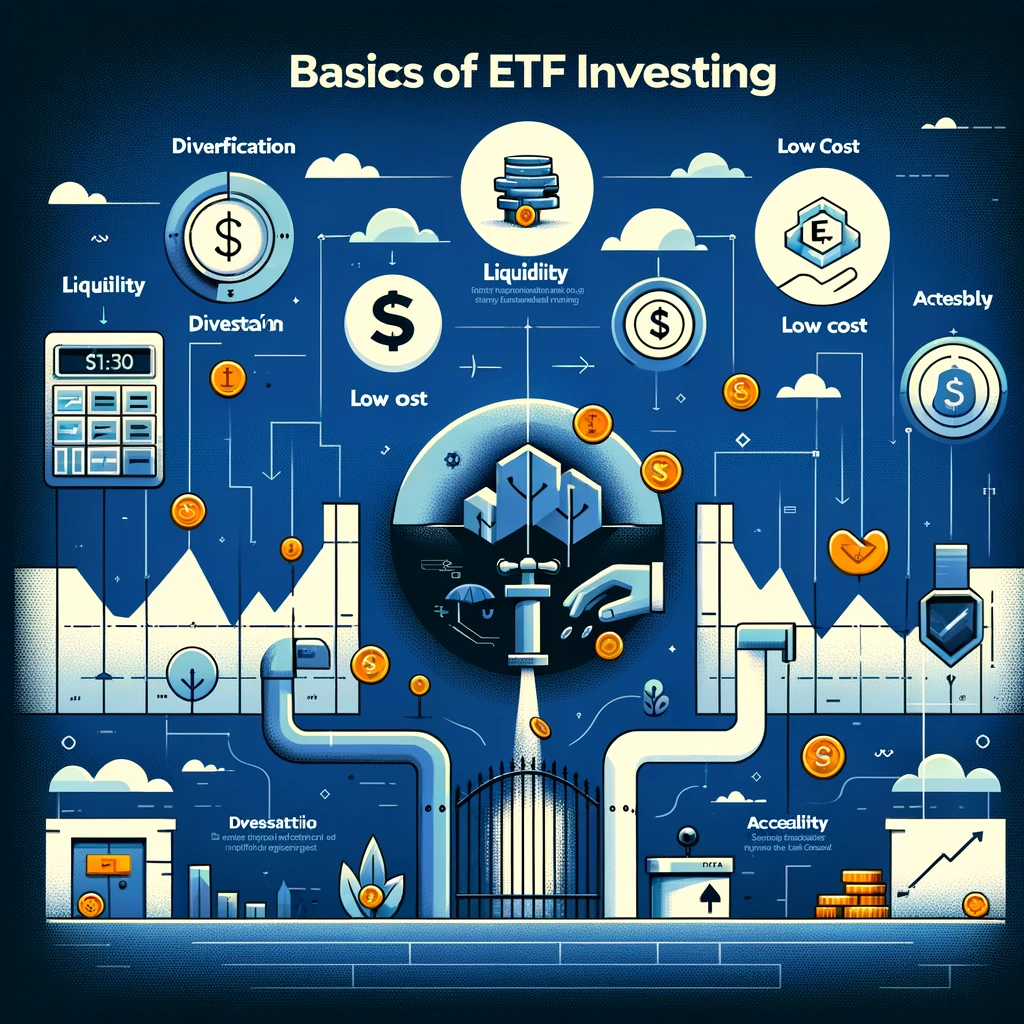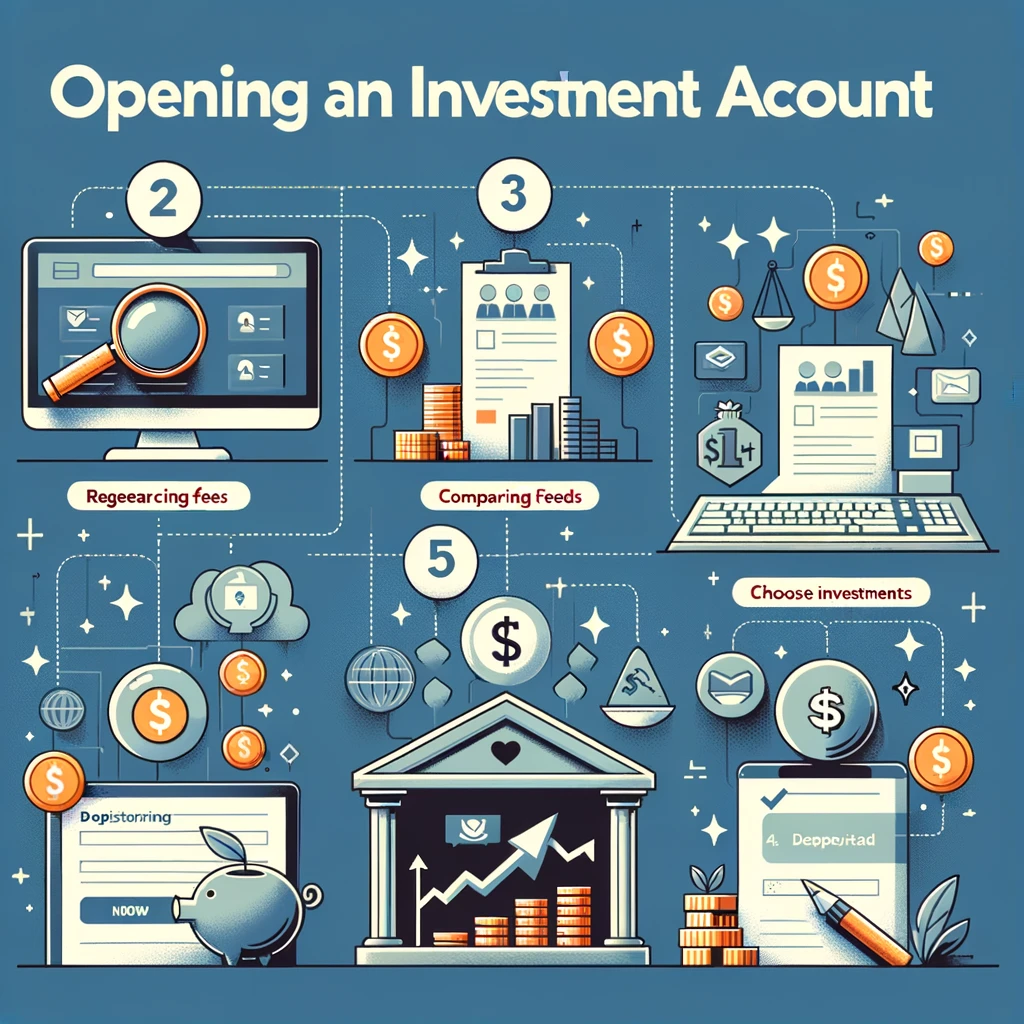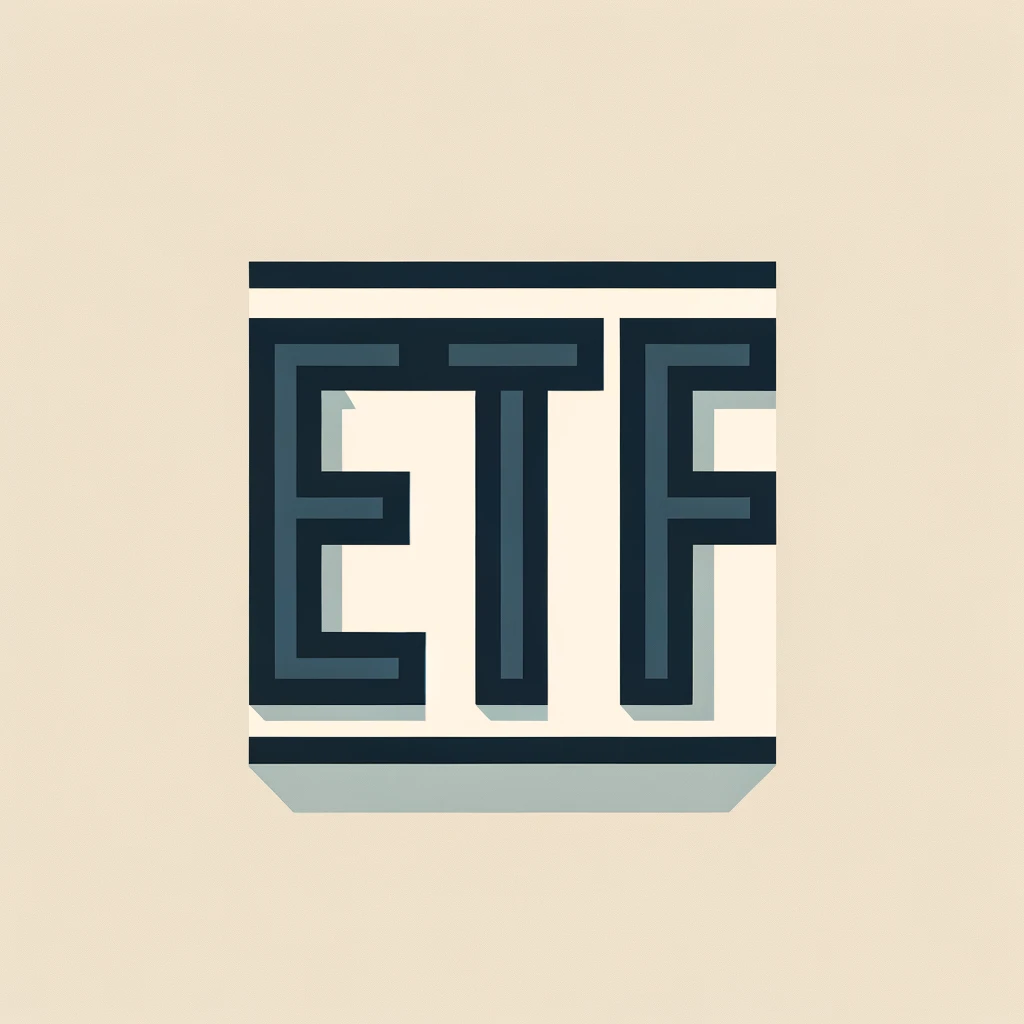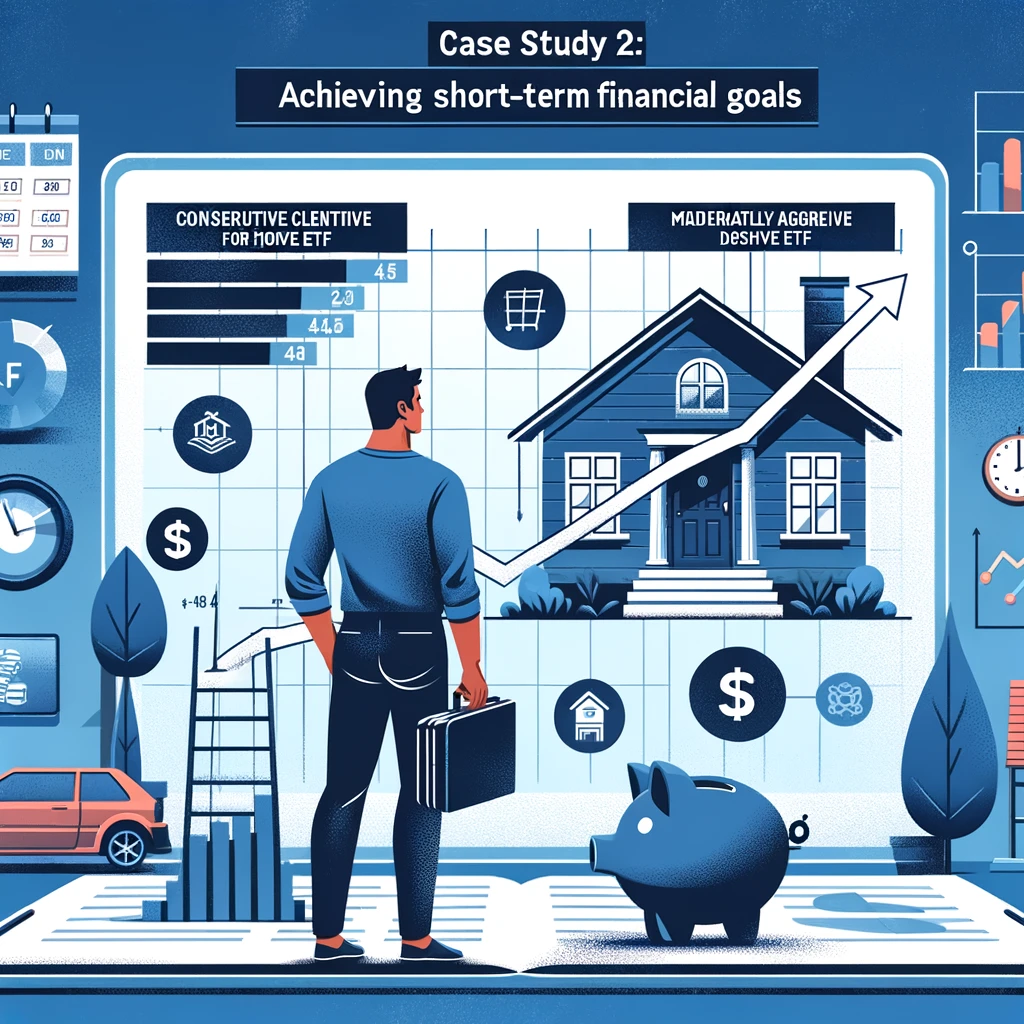
Introduction to ETFs:
Investing is a fundamental tool for achieving financial growth and securing your future. If you’re new to the world of investing, Exchange-Traded Funds (ETFs) offer an accessible and versatile option. In this comprehensive guide, we’ll explore the ins and outs of ETF investing, providing beginners with the knowledge needed to confidently navigate this investment strategy.

What Are ETFs?
An ETF is a type of investment fund that’s traded on stock exchanges, similar to individual stocks. ETFs offer exposure to a diversified portfolio of assets, such as stocks, bonds, commodities, or real estate. They combine the benefits of mutual funds—diversification and professional management—with the flexibility of individual stock trading.
Benefits of ETF Investing
- ETFs come with a range of benefits that make them particularly appealing to beginners. They provide instant diversification across various assets, reducing the risk associated with investing in individual stocks. ETFs also typically have lower expense ratios compared to actively managed funds. Additionally, they offer liquidity, as they can be bought and sold throughout the trading day, unlike mutual funds that are priced and traded at the end of the day.
Understanding ETF Performance:
- The performance of an ETF is closely tied to the performance of the underlying assets it holds. As the value of these assets fluctuates, the value of the ETF shares will also change. It's important to note that while past performance can offer insights, it's not a guarantee of future results. Investors should evaluate ETF performance in the context of their long-term investment goals.
The Basics of ETF Investing:

Before diving into ETF investing, take time to define your investment goals. Are you saving for retirement, a major purchase, or another financial milestone? Understanding your objectives will help shape your investment strategy and risk tolerance.
ETFs cover a wide range of asset classes, sectors, and strategies. Beginners should start by selecting ETFs that align with their goals and risk tolerance. You can choose broad-market ETFs, sector-specific ETFs, bond ETFs, or even niche ETFs that focus on specific themes, such as technology or sustainable investing.
Expense ratios represent the annual fees and costs associated with managing an ETF. Lower expense ratios lead to higher returns for investors. Compare the expense ratios of different ETFs in the same category to ensure you’re making cost-effective choices.
Opening Your Investment Account:
To invest in ETFs, you’ll need to open an investment account with a brokerage. Choose a reputable brokerage that offers a user-friendly platform, low trading fees, and a diverse selection of ETFs. Research and read reviews to find a brokerage that suits your needs.
The process of opening an investment account is usually straightforward. You’ll need to provide personal information, verify your identity, and agree to the brokerage’s terms and conditions. Most of this can be done online.
Once your account is set up, you can fund it through various methods such as bank transfers, wire transfers, or check deposits. Once your account is funded, you’re ready to start investing in ETFs.

Creating a Diversified Portfolio:
Diversification involves spreading your investments across different asset classes and sectors to reduce risk. ETFs inherently offer diversification because they hold a basket of assets. A diversified portfolio can help mitigate the impact of a single underperforming investment on your overall wealth.
Deciding how much to allocate to different types of ETFs is known as asset allocation. It depends on your risk tolerance and investment goals. A common strategy is to allocate more to equities (stocks) for growth and a smaller portion to fixed-income (bonds) for stability.
Over time, your asset allocation can drift from your original targets due to varying performance among your investments. Periodically rebalancing your portfolio involves selling assets that have grown and reinvesting in those that have underperformed. This ensures your portfolio remains aligned with your chosen allocation.
Making Informed Investment Decisions:
-
Understanding ETF Holdings:
Before investing in an ETF, research the holdings it includes. This information is usually available on the ETF provider's website or through your brokerage's platform. Understanding the assets within the ETF can help you anticipate its potential performance and risks.
-
Researching ETF Performance:
Analyze an ETF's historical performance to understand its behavior in different market conditions. Compare the ETF's performance to its benchmark index to assess how closely it tracks its target. However, keep in mind that past performance doesn't guarantee future results.
Comparing Different ETFs
If multiple ETFs meet your investment criteria, compare them based on expense ratios, tracking error, and other relevant factors. Choose the one that best aligns with your goals and provides the most cost-effective option.
Dollar-Cost Averaging vs. Lump-Sum Investing:
Dollar-Cost Averaging Strategy:
Dollar-cost averaging involves investing a fixed amount of money at regular intervals, regardless of market conditions. This approach can help mitigate the impact of market volatility by buying more shares when prices are low and fewer shares when prices are high.
Lump-Sum Investing Approach:
Lump-sum investing involves investing a larger sum of money all at once. This method can be advantageous if you believe the market is favorable. However, it exposes your investment to potential short-term fluctuations.
Pros and Cons of Each Method:
Dollar-cost averaging reduces the risk of making a large investment at the wrong time, while lump-sum investing can take full advantage of potential market upswings. The choice between the two depends on your risk tolerance and investment strategy.
Tax Considerations in ETF Investing:
Tax Efficiency of ETFs:
ETFs are known for their tax efficiency due to their structure. They have lower turnover compared to actively managed funds, leading to fewer capital gains distributions. This can result in lower tax liabilities for investors.
Tax-Advantaged Accounts (IRAs, 401(k)s):
Investing in ETFs within tax-advantaged accounts, like Individual Retirement Accounts (IRAs) and 401(k)s, offers additional tax benefits. Contributions to these accounts may be tax-deductible or made with pre-tax income, reducing your current tax burden. Additionally, gains within these accounts are tax-deferred until withdrawal.
Capital Gains and Dividend Taxes:
When you sell ETF shares at a profit, you may incur capital gains taxes. The tax rate depends on how long you held the investment before selling. Dividends earned from ETFs are also subject to taxation, either as ordinary income or at a qualified dividend tax rate.



Managing Your ETF Investments:
-
Regular Portfolio Review:
Frequently reviewing your ETF investments is crucial to ensure they continue to align with your goals. Evaluate the performance of each ETF, track your asset allocation, and consider rebalancing if necessary.
-
Adjusting Your Investment Strategy:
Life circumstances and financial goals can change. Be prepared to adjust your investment strategy accordingly. If your risk tolerance changes or you have new financial objectives, revisiting your asset allocation and investment choices is important.
-
Staying Informed About Market Changes:
Stay informed about market trends, economic indicators, and global events that could impact your investments. This knowledge will help you make informed decisions based on current market conditions.
Common Misconceptions and Pitfalls:
-
Active vs. Passive ETF Investing:
Some investors mistakenly believe that actively managed funds consistently outperform passive ETFs. Research shows that the majority of actively managed funds fail to consistently beat their benchmarks over the long term.
-
Avoiding Emotional Investing:
Emotions can lead to impulsive investment decisions based on short-term market fluctuations. Avoid emotional investing by adhering to your long-term investment strategy and avoiding knee-jerk reactions.
-
The Myth of Market Timing:
Attempting to time the market—predicting when to buy or sell based on short-term trends—is challenging and often leads to suboptimal results. ETF investing promotes a long-term perspective that focuses on gradual wealth accumulation.
Leveraging ETFs for Specific Goals:
-
Sector-Specific ETFs:
Sector-specific ETFs allow you to target specific industries or sectors, such as technology, healthcare, or energy. These ETFs can be useful if you want exposure to specific segments of the economy.
-
International and Emerging Market ETFs:
International and emerging market ETFs provide exposure to global markets. These ETFs can add diversity to your portfolio and tap into regions with growth potential.
-
Bond and Fixed-Income ETFs:
Bond ETFs invest in fixed-income securities, providing stability and income. They can be suitable for investors seeking a more conservative component in their portfolio.
ETF Investing During Market Changes:
-
Navigating Bull and Bear Markets:
ETFs can perform differently during bull (rising) and bear (falling) markets. During bull markets, equity ETFs tend to rise. In bear markets, equity ETFs can decline, but diversification within the ETF can mitigate losses.
-
Investing Amidst Economic Uncertainty:
During economic uncertainty, investors often seek the stability of ETFs due to their diversified nature. While short-term fluctuations may occur, the historical performance of ETFs underscores their potential for growth over the long term.
-
Long-Term Investment Mindset:
ETF investing is ideally suited for a long-term investment horizon. While market fluctuations are normal, the diversified nature of ETFs allows them to recover and potentially deliver solid returns over extended periods.
Lorem ipsum dolor sit amet, consectetur adipiscing elit. Ut elit tellus, luctus nec ullamcorper mattis, pulvinar dapibus leo.

Case Study 1: Building a Retirement Portfolio:
Consider Sarah, who is planning for retirement. She chooses a mix of ETFs that align with her risk tolerance and investment objectives. Over time, she consistently invests a portion of her income into her ETF
portfolio. As retirement approaches, her disciplined approach results in a diversified portfolio that has grown steadily, providing financial security in her retirement years.
Case Study 2: Achieving Short-Term Financial Goals:
John has a shorter investment horizon. He’s saving for a down payment on a house in five years. He chooses a combination of conservative and moderately aggressive ETFs to match his timeline and risk appetite. By sticking to his investment plan, he accumulates enough funds for a down payment on his dream home.

Seeking Professional Guidance: Financial Advisors and Consultants:
While ETF investing is accessible, there are situations where professional guidance is valuable. Complex financial situations, tax optimization, and personalized investment strategies may warrant the expertise of a financial advisor.
When selecting a financial advisor, consider their qualifications, experience, and fiduciary responsibility. Interview multiple advisors to find one who understands your goals and values.
Financial advisors can assist with constructing a diversified portfolio, determining asset allocation, and providing guidance during market fluctuations. They can help you navigate the nuances of ETF investing and ensure your investments align with your overall financial plan.
Frequently Asked Questions (FAQs):
ETFs and mutual funds each have their advantages. ETFs offer intraday trading and potentially lower expenses, while mutual funds can be purchased with fractional shares and have no trading commissions.
Yes, it’s possible to lose money in ETFs, particularly during market downturns. However, the diversification within ETFs can mitigate losses compared to investing in individual stocks.
ETF dividends are paid based on the income generated by the assets within the ETF. Dividends are typically distributed to investors on a regular basis, similar to the dividends paid by individual stocks.
ETF investing provides a powerful tool for beginners to enter the world of investing with confidence. By understanding the fundamentals of ETFs, assessing your investment goals, and making informed decisions, you can harness the benefits of this versatile investment strategy. Whether you’re planning for retirement, pursuing short-term objectives, or seeking financial security, ETFs offer a flexible and efficient way to invest your money. Keep in mind that successful investing requires patience, discipline, and a long-term perspective. As you embark on your ETF investment journey, continue learning, adapting, and focusing on your financial aspirations.

This article was written by:
Benjamin the Bull
I write about companies that fascinate me and that also offers investors with potential as a long-term position. I primarily focus on the energy and industrial sector but every now and again venture out to other sectors too.
Bull Bear Vector’s Disclosure: Past performance is no guarantee of future results. No recommendation or advice is being given as to whether any investment is suitable for a particular investor. Any views or opinions expressed above may not reflect those of Bullbearvector as a whole. Bullbearvector is not a licensed securities dealer, broker or US investment adviser or investment bank. Our analysts are third party authors that include both professional investors and individual investors who may not be licensed or certified by any institute or regulatory body


